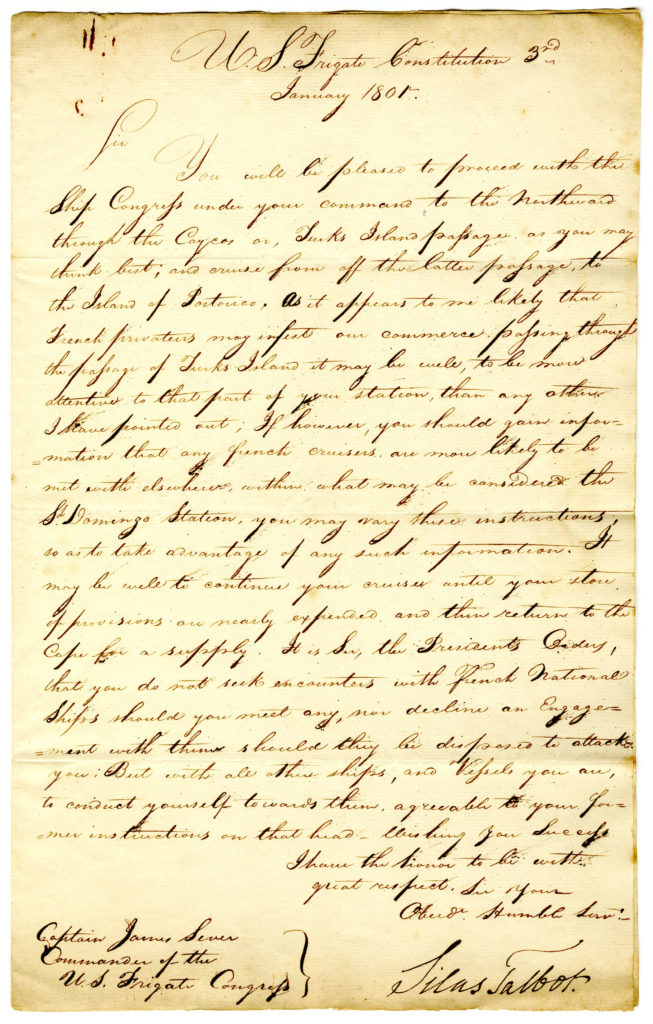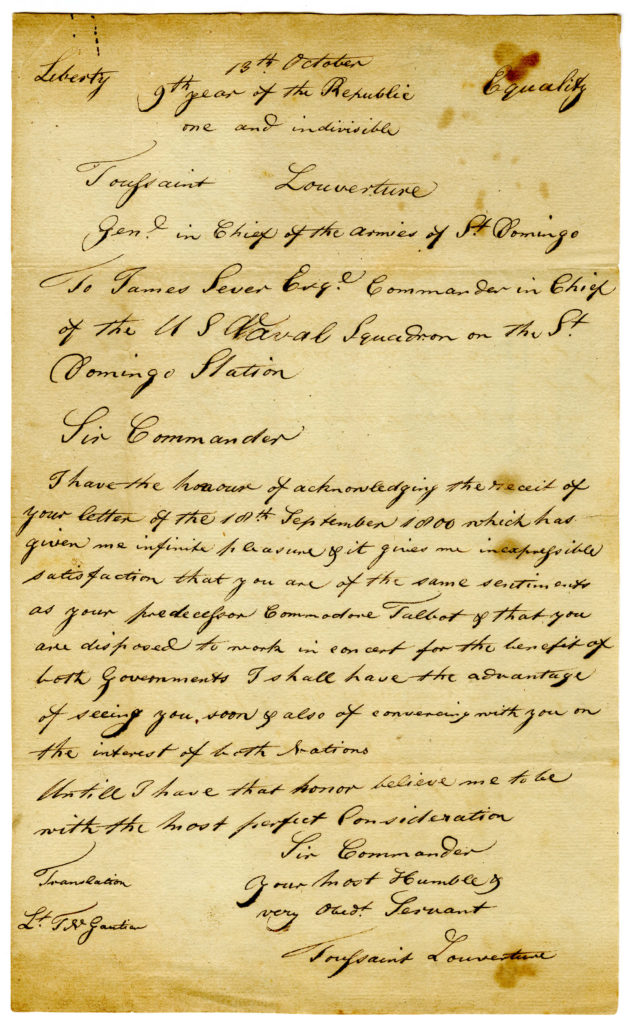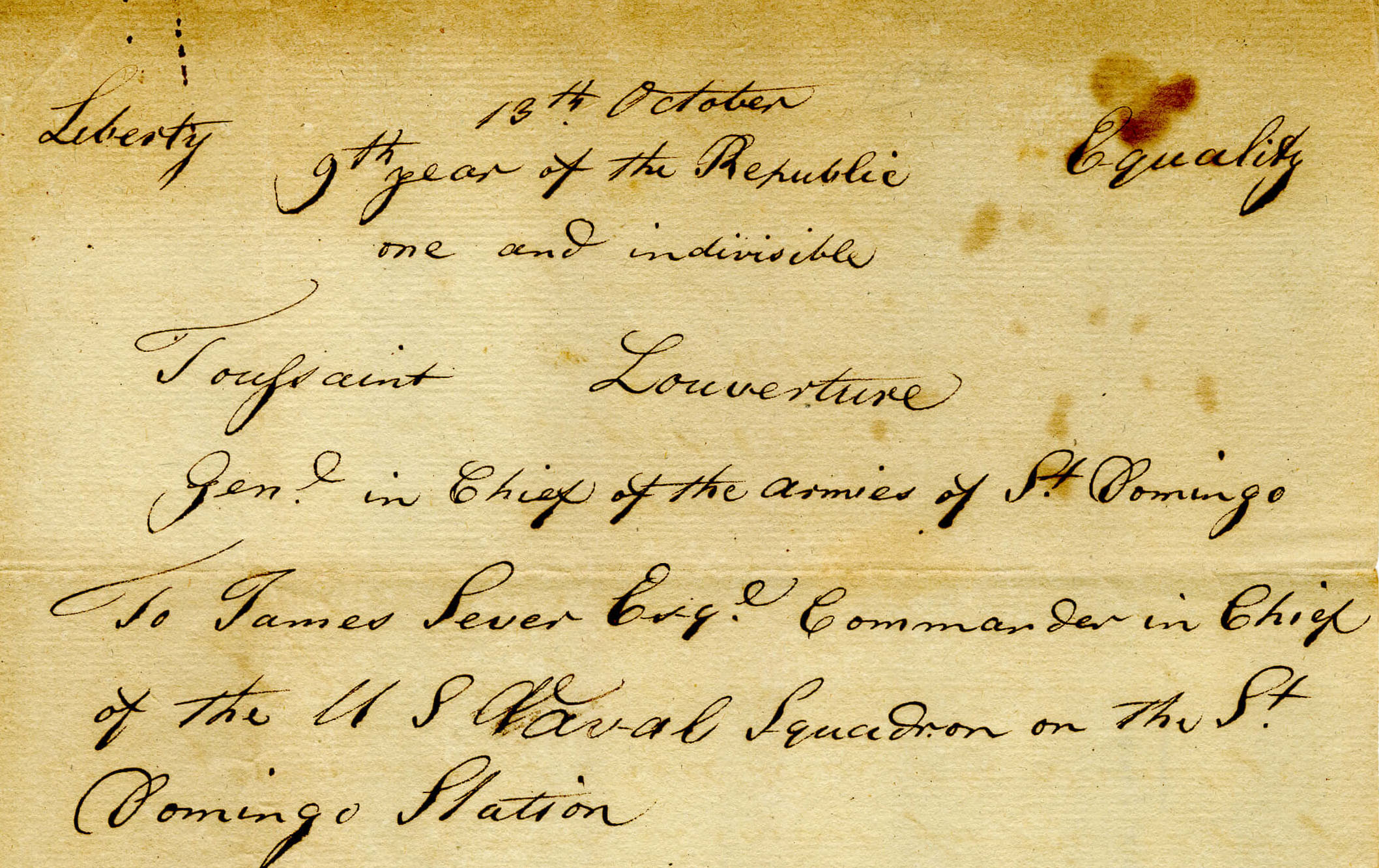On January 3, 1801, Captain Silas Talbot wrote a set of orders to Captain James Sever, in command of USS Congress.
In his orders, Talbot, who was serving as commodore of the West Indies Squadron off Cap-François (now Cap-Haïtien), described in detail his expectations for Sever. He was to depart the Cape, sail north through the Turks and Caicos Islands, and patrol the area between the islands and Puerto Rico to the southeast. This location, Talbot thought, was where Sever would mostly likely find the French privateers that were threatening U.S. merchant ships. But, Talbot told him, Sever could change that focus and sail elsewhere if he found better information. He was to capture any French privateers, but was not to engage French Navy ships unless they fired first on Congress.

Talbot’s orders are among the more than 130 documents once belonging to Sever that were acquired by the USS Constitution Museum in 2020. Collectively, the James Sever Collection1 provides a unique window into the complex nature of America’s early involvement in the Caribbean and the struggles facing the new U.S. Navy as it became an instrument of American diplomacy abroad.
As part of its approach to securing trade in the Caribbean, the United States had chosen to support General Toussaint Louverture in his efforts to control Saint-Domingue. Louverture was one of the early leaders of the Haitian Revolution that would eventually lead to the establishment of the independent nation of Haiti in 1804. The long Haitian Revolution began with an armed uprising by enslaved people in 1791 that coincided with the collapse of the monarchy in France as part of the French Revolution. The uprising was motivated in part by the belief among the enslaved people that King Louis XVI was ending slavery on the island.
Over the course of the decade-long conflict, the United States, Great Britain, Spain, and France itself sought to choose sides to best suit their own goals and aspirations for control of the island and the region. Those allegiances shifted as the nature of the conflict on the island evolved. For the United States, the conflict set the tone for future, ongoing American intervention in the Caribbean.
When the United States decided to deploy ships to the Caribbean, a crucial part of the mission involved securing American access to the trading ports in Saint-Domingue and the seaways along the coast. Louverture had control of the north coast of the island, but rival military leader Benoit Joseph André Rigaud had control of the south coast. The colony had fallen into civil war. The United States sided with Louverture in what became the United States’s first diplomatic engagement on equal footing with a Black leader. Louverture, who was formerly enslaved, had himself become a planter. His economic ideas for continuing the island’s plantation economy suited American economic interests on the island, in spite of white American fears of similar uprisings. Although Saint-Domingue was still considered a French colony and the Americans had suspended trade with France in 1798, trade with Saint-Domingue continued.

In a set of orders issued in June 1800 to Master Commandant David Jewett commanding USS Trumbull, Talbot wrote that the goal was to ensure Rigaud’s army “will be more distressed, and the sooner reduced to Submission as it is of great consequence to the United States to have Rigaud’s force subdued, for it has hitherto kept up a Constant and cruel Warfare on the lives, and property of the Citizens of the U. States.” Similar orders went out to nearly all the ships in the squadron: Convoy Americans, capture French privateers, harass Rigaud, but don’t actively engage the French Navy.
On February 27, 1800, Captain Christopher Raymond Perry of USS General Greene participated in an attack against Rigaud in the city of Jacmel on the southern coast. Perry had been primarily ordered to protect U.S. shipping along the south coast. But, after meeting up with Louverture, Perry decided to assist him in assaulting Rigaud’s forces at Jacmel. The attack was planned by Louverture, whose army attacked from the land, while General Greene bombarded Rigaud’s forts from offshore. The attack was a critical success and could be considered the first time that a U.S. warship engaged in support of an American ally.
Louverture expressed his gratitude to Perry with a gift of 10,000 pounds of coffee, to be distributed among the crew. The gift generated significant controversy, however, as some in the U.S. Navy thought it constituted a bribe and was designed as inducement to other American captains to extend greater assistance.
In his June orders to Jewett, just a few months after the Jacmel battle, Talbot warned against impropriety: “Should General Toussaint be disposed to make you any presents, as a reward for the Service you may render him, you must decline acceptance of all such bounty as not consistent with the honor, and dignity that ought to be preserved in the American Navy,” Talbot wrote. The gift to the General Greene “makes it necessary for me to mention this and to put a stop to a precedent.”
Louverture was arrested by French forces after Napoleon Bonaparte sent in troops to retake control of the island in 1802, but French intentions to reinstate slavery reignited the rebellion against French authority. Occupied by a renewed war with Britain, France could not afford to divert resources to control Saint-Domingue for long.
On January 1, 1804, Jean-Jacque Dessalines declared the colony to be the independent nation of Haiti and became its first ruler. He immediately ordered a massacre of all the remaining white French population, with few exceptions. By April, an estimated 3,000 to 5,000 people had been killed, shutting the new nation off from any trade or investment by American or European nations for decades after.
1 All information and quotes included in this article are sourced from the James Sever Collection [USS Constitution Museum Collection, 2506.1.]
* * *
This article has been made possible by a Sustaining the Humanities through the American Rescue Plan (#SHARP) grant from the National Endowment for the Humanities: Democracy demands wisdom. Any views, findings, conclusions, or recommendations expressed in this article do not necessarily represent those of the National Endowment for the Humanities.
The Author(s)
Carl Herzog
Public Historian, USS Constitution Museum
Carl Herzog is the Public Historian at the USS Constitution Museum.
